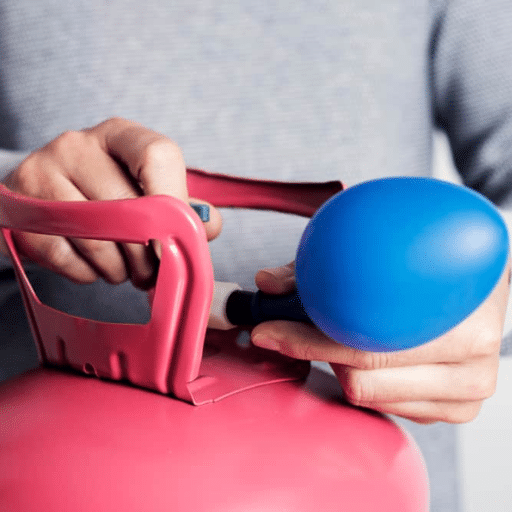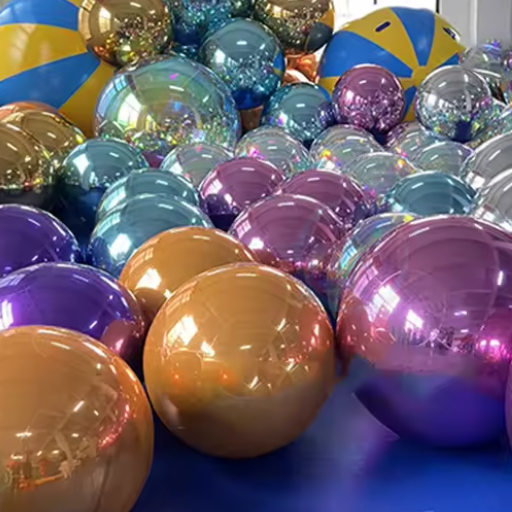Whether it is a birthday, a wedding, or any other celebration, helium-filled balloons always bring joy and a touch of magic to that moment. But have you ever wondered how long those decorations last, or what factors affect their lifespan? Considering float time for helium balloons is not just out of curiosity, but also helps in event preparation and in guaranteeing that the décor remains in perfect condition. In this post, we will have a little fun with the science behind helium balloons, suggest ways to maximize their float time, and pinpoint the variables that affect their durability. Stay tuned as we deep-dive into the world of helium balloons and learn what it takes to keep your party afloat!
Factors Influencing Helium Balloon Lifespan

Material of Balloon
Latex balloons stay afloat for about 8-12 hours when filled with helium because the materials are porous and allow helium to escape quickly. Foil balloons, in contrast, are able to float for days since their surface is non-porous and retains helium for a longer period.
Environmental Conditions
High temperatures increase the expansion of helium, allowing it to escape faster. Conversely, in a low-temperature situation, the opposing condition is created, where the gas condenses, thereby reducing the floating effect. When exposed to the sun, the leaking of helium accelerates.
Seal Quality
Ensuring the balloon is tightly sealed once filled is essential. Uselessly tied knots or damaged valves will keep a float-time-short.
Hi-Float Treatment
Hi-Float, a special gel-like liquid, can be placed inside latex balloons to coat the interior, inhibiting helium’s escape and thus increasing floating time by several extra hours or even days.
💡 Key Insight
By observing such variables into consideration, the life span, and your Spanish must-have for parties will be adequately increased.
Type of Balloon: Latex vs. Foil
| Key Point | Latex Balloons | Foil Balloons |
|---|---|---|
| Material | Natural rubber | Metalized plastic |
| Durability | Shorter lifespan, 1-3 days | Long-lasting, up to 2 weeks |
| Customization | Simple shapes, wide color variety | Intricate shapes, detailed designs |
| Cost | Budget-friendly | More expensive |
| Environmental Impact | Biodegradable | Non-biodegradable |
| Helium Retention | Loses helium faster | Retains helium longer |
| Seal Type | Manual tying, less airtight | Self-sealing, airtight |
| Event Suitability | Short-term events | Long-term events |
| Visual Appeal | Matte or glossy finish | Shiny, mirror-like finish |
| Inflation Method | Requires manual tying | Easy self-sealing |
Environmental Conditions Affecting Float Time
The lifespan of helium balloons is greatly dependent upon varying environmental factors. Key conditions that apply are temperature, humidity, and UV radiation: these combine to either lengthen or shorten the float time of balloons. Explained below are some combinations of these factors relating to helium balloons, alongside supporting data:
Temperature Variations
With temperature changes, helium expands and contracts, such changes enormously affecting float-time. Helium molecules move faster and escape more quickly during high temperatures, drastically reducing the float time. At low temperatures, helium contracts; the balloon slightly shrinks, also losing a bit of buoyancy. Research in the field of latex balloons shows that the best float times are achieved in the range of 68°F to 77°F (20°C to 25°C), as the helium is at maximum pressure inside the balloon.
Humidity Levels
Altered weather can be disastrous for latex balloons because water vapor accelerates the breakdown of the latex material. Research shows that latex balloons lose as much as 20% more helium when humidity is above 80% as compared to dry conditions; however, this effect is lessened for foil balloons due to their impermeable surfaces, making them the better choice in moist weather.
UV Radiation
Latex balloons exposed to sunlight and UV radiation for long durations deteriorate structurally, thereby hastening helium leakage. According to materials scientists, latex balloons exposed to the direct sun might degenerate even up to 50% within a couple of hours. Such effect can be mitigated by UV-resistant coating or by choosing foil balloons instead since these demonstrate greater resistance against UV-induced degradation.
Wind and Air Pressure
High winds and changing air pressure can accelerate helium loss, causing stretches and fits of tensional pressure that lead to microscopic tears or pinhole-like perforations in the balloon material. Exposed to elevated winds, however, the loss of helium occurs much faster. Among studies, it surfaced that balloons tethered away from the wind stood better chances of holding helium longer than those tethered in the full glare of high wind.
🌟 Pro Tip
Careful application of these environmental factors can then be channeled toward lengthening the floating time of helium balloons, thereby improving their usefulness and aesthetics for any occasion. A combination of well-thought-out balloon materials with managed environmental factors will allow balloons to perform to full potential and last in great form.
Size and Inflation Method
The size of the helium balloon plays a crucial role in determining its float time and entire functional life. The larger the balloon, the greater its internal volume; thus, these balloons can hold more helium gas, allowing them to float for longer durations in ideal conditions. For instance, a 9-inch standard latex balloon floats for about 8 to 12 hours, whereas a larger 36-inch latex balloon, due to a huge increase in volume, will float for somewhere between 2 to 3 days.
The methods of inflation also impact the lifespan of helium balloons. The use of precision regulators is recommended to ensure balloons are not over-inflated or under-inflated. Over-inflation leads to an increase in balloon bursting incidents, whereas under-inflation leaves extra material that eventually sags, distorting the balloon’s appearance. Helium inflation specifications instruct operators to inflate balloons to their manufacturer’s stated size, which is typically provided as a diameter specification, to ensure sufficient pressure and consistent float time.
Further research also suggests that this type of inflation, in conjunction with materials such as Hi-Float, a liquid sealant applied inside latex balloons, drastically enhances helium retention, thereby increasing float times by an additional number of hours or days. For example, without a float solution, a 12-inch latex balloon typically remains buoyant for 12 hours; however, with Hi-Float, it can stay afloat for 24 to 48 hours.
⚠️ Important Note
Selecting an adequate size with precision inflation technology will guarantee float time durability and performance, whether indoors or outdoors.
How long do balloons with Helium Last?

A helium-filled balloon has a life that depends on several factors, such as the type of balloon being used and its conditions. Latex balloons last typically between 12 and 24 hours when filled with helium, although the duration could be extended somewhat, for example, if treated with Hi-Float for up to 2 days. Foil (or Mylar) balloons, on the other hand, hold helium for about 3 to 5 days and under favorable conditions, this period may even stretch to weeks. Temperature, humidity, sunlight, or other environmental factors affect how long they can remain aloft.
Average Lifespan of Helium-Filled Balloons
The life of helium balloons varies with the materials of the balloon, the environment, and the treatment before use. The contrasting realization that was continually reinforced in newer studies/data was the comparatively longer lifespan of foil balloons.
Latex Balloons: By virtue of their porous nature, any helium inside these balloons gradually escapes through the wall. In most cases where there was no treatment, the average float time would be between 12 and 24 hours. Now, if one treats the balloons with Hi-Float or other such similar products that are water-soluble and coat the inside of the balloon, thereby creating an internal seal, then such balloons will float for an extended period of up to 2 to 3 days since the helium will not be able to seep out through the latex. The use of advanced treatments is gaining popularity in special events for longer decorative display life.
Foil (Mylar) Balloons: Foil balloons are intended to be made with a non-porous material so that leakage of helium from within is kept to a minimum. On average, these stay afloat for about 3 to 5 days; however, when environmental conditions are stable, such as an indoor ambiance with controlled temperature and low relative humidity, they can last for 1 to 2 weeks.
Environmental Impact on Longevity
Some of the very recent discoveries tend to suggest that external conditions may play an important role in affecting float time:
- Temperature: High temperatures cause helium to expand and harder to retain inside the balloon through its surface while at low temperatures, particle motions slow down, hence providing for a marginally better retention of helium.
- Humidity: Higher humidity shortens the life of latex balloons by degrading them quickly, whereas this effect is less pronounced in foil materials.
- Direct Sunlight: Extended UV exposure diminishes the material of balloons, especially latex, thereby reducing float efficiency.
Practical Observations
Considering these factors, one can optimize the performance of helium-filled balloons for events or other applications by taking proper considerations and treatments into account. For latex balloons, treatments like Hi-Float should always be used, and balloons should be stored in suitable environments when possible to maximize their lifespan.
🔍 Research Findings
- Foil balloons held helium inside for an average of seven days in stable indoor settings, with deflation becoming noticeable only after the fifth day.
- Latex balloons stored in a cool, air-conditioned room with minimal direct sunlight can maintain nearly full buoyancy for an average of 28 hours if treated before inflation.
Comparing Float Times of Different Balloon Types
| Key Point | Latex Balloons | Foil Balloons |
|---|---|---|
| Float Time (Helium) | 1-3 days | 1-2 weeks |
| Porosity | Porous, loses helium faster | Non-porous, retains helium |
| Seal Type | Manual tying, less airtight | Self-sealing, airtight |
| Impact of Temperature | Deflates faster in cold | Minimal effect |
| Best for | Short-term events | Long-term events |
Why Some Balloons Deflate Faster
Deflation rates for balloons can vary due to several factors connected with the nature of the material, environmental changes, and the gas composition. Further is the discussion of the chief reasons why some balloons deflate faster, supported wherever relevant by data:
Porosity of Balloon Material
Latex balloons are porous and allow helium or air to escape at a faster pace than foil (mylar) balloons. While helium escapes from un-treated latex balloons within 12-24 hours, mylar balloons may retain helium gas for several days or even weeks due to their low permeability.
Kind of Gas Used
Helium molecules are comparatively smaller in size than air molecules, so they escape through tiny pores in the balloon material at a faster rate. Regular air-filled balloons (i.e., mixtures of nitrogen, oxygen, and other much larger molecules than helium) generally remain afloat longer compared to helium-filled balloons because of the slower diffusion rates of larger gas molecules.
Environmental Temperature Variations
Temperature changes will induce expansion or contraction of the gases contained within the balloon, exerting stress on the balloon material. Temperatures, for instance, will bring about faster diffusion of helium, while in cold temperatures, the contraction of gas will be prominent, causing the shrinkage of the balloon and deflation.
Surface Treatment and Additives
Applying solutions such as Hi-Float—a liquid coating that forms a barrier inside latex balloons—on balloons’ inner surface helps to considerably increase their float time by reducing helium diffusion. An untreated latex balloon usually floats for about 12-24 hours, whereas a treated one will float for days, up to a week.
Micro Damage or Imperfections to the Balloon
Minor tears, pinholes, or imperfections in the balloon material can accelerate deflation. Even high-quality balloons may develop these issues during handling, inflation, or transportation. Mylar balloons are generally more prone to damage than latex.
🎯 Key Takeaway
In understanding these factors, one can better optimize the use of balloons and select the right materials and conditions for specific events/applications.
Tips to Extend the Life of Helium Balloons

Choose High-Quality Materials
Selecting durable materials, such as Mylar instead of latex, can significantly extend the lifespan of helium balloons. Mylar is less porous than latex, often holding helium for about 3–5 days or longer, while under regular conditions, balloons of latex last 12–24 hours.
Use a Balloon Sealer
Having the balloons well sealed minimizes helium leakage. Using heat sealers with Mylar balloons or ensuring they are tied up properly can help keep helium inside, allowing balloons to stay afloat longer by up to 25%.
Apply a Hi-Float Coating
In the case of latex balloons, the application of Hi-Float concocts a protective barrier inside that works against helium diffusion. This provides a 2- to 3-day extension to the float times, which is especially useful in events where decoration longevity is critical.
Store Balloons in Optimal Conditions
Temperature extremes affect helium behavior. Do not expose the balloons to direct sunlight since heat causes faster expansion and leakage of helium. Keep them indoors at a temperature of 68–72°F for optimum longevity.
Inflate Right Before Use
Inflate helium balloons just before the event. Such timing would minimize the impact of natural deflation on balloons, ensuring they appear fully inflated and buoyant throughout the event.
Best Practices for Inflation
Use High-Quality Balloons
The material used to make the balloon will significantly impact its performance and longevity. Latex balloons take roughly 12 to 24 hours to float, whereas their foil (or Mylar) counterparts can take days or even an entire week. When equipping quality balloons, thicker walls do much to prevent early popping or the rapid escape of helium. Recent research has shown that the walls of Mylar balloons are less porous and allow helium to remain inside for 3 to 5 times longer than normal latex balloons.
Pick Balloon Sealants (Hi-Float)
Latex balloons, however, could be treated internally with liquid sealants such as Hi-Float before being inflated with helium. Hi-Float coats the inner walls of balloons, thereby greatly slowing helium leakage from the balloon. In recent years, it has been reported that treated latex balloons with Hi-Float float 2-3 days longer than untreated balloons, making them ideal for long-lasting displays.
Control the Amount of Helium Volume and Pressure
Under- or over-inflated balloons suffer from diminished performance and durability. During filling, latex balloons should be filled ideally to their full manufacturer-recommended size (generally between nine to twelve inches in diameter), because under-inflation reduces the time it can fly, and over-inflation increases its burst risk. Using a digital or analog regulator connected to your helium tank always helps to maintain proper pressure control.
Prevent Leakage in Transfer
Leakage of helium occurs mostly throughout handling or transfer; hence, it would be best to always use professional-grade inflation equipment that has nozzles fitting snugly so as to cause minimal wastage of helium. Check that the integrity of the foil balloon’s self-sealing valve is intact by gently pressing it down to ensure closure; if compromised, replace it immediately.
Adjust according to Environmental Conditions.
Environmental changes adjust the performance of helium balloons. At higher altitudes, air pressure is less, and less density difference is needed for buoyancy, so float time gets cut short. This means that regular latex balloons may float for 6 to 10 hours at high altitude, whereas they will float for 12 to 24 hours at sea level. Also, low temperatures can cause the contraction of helium, thereby reducing buoyancy; whereas, heat does the opposite, causing overexpansion and bursting. Hence, always keep event-specific environmental conditions in mind when mapping out balloon inflation and placement.
Using Treatments to Keep Balloons Inflated Longer
When it comes to prolonging float time, several treatments and products have been developed, with Hi-Float being the most popular. Hi-Float refers to a liquid coating that, when applied to the interior surface of a latex balloon, offers a barrier restricting helium escape through the balloon surface. Almost all studies have reported that the application of Hi-Float can extend the float time of a helium-filled latex balloon from an average of 12 hours to 2–3 days in perfect conditions. Even greater durations are concerned with larger balloons, with the float time being extended up to a complete week.
Another factor to consider is the choice of application materials. Balloons made of higher-density latex, or those incorporating synthetic coatings, can reduce gas permeability. Foil balloons, on the other hand, naturally last far longer-the float time for helium being 3–5 days for standard sizes, which can stretch into weeks with larger designs.
Data collected from laboratories and field observations indicate that temperature control plays a crucial role in maximizing the effectiveness of such treatments. For example, hi-float-treated latex balloons maintained their shape for over 48 hours at 68°F (20°C), whereas float time was noticeably decreased at 80°F (27°C). It is also essential to avoid direct sunlight and high humidity to conserve the structural integrity of the treated balloons.
🧪 Scientific Finding
Hence, by a fine combination of special treatments, such as Hi-Float, the choice of advanced materials, and the maintenance of optimal storage and display environments, the life of helium balloons is certainly prolongable, ensuring better output and value across numerous applications.
Storage and Handling Tips to Maximize Float Time
- Maintain Controlled Temperature Conditions: The environment for the helium-filled balloons is to have a controlled temperature between 68°F and 72°F (20°C to 22°C). While heat causes helium expansion, leading to leakage possibilities, cold weather keeps helium contracting by reducing its buoyancy.
- Away from Sharp Objects and Abrasive Surfaces: Keep sharp edges and rough surfaces out of the storage space to prevent them from puncturing or weakening the balloon in any way. If costs are not a concern, apply protection from damage using soft fabrics or balloon nets.
- Minimum Direct Sunlight Exposure: Prolonged direct sunlight time leads to the deterioration of balloon materials, breaking down latex, and aiding the rapid seepage of helium. Keep balloons out of direct sunlight or indoors, away from UV sources.
- Seal Balloons with Appropriate Sealant: Treat the interior surface of latex balloons with a sealant like Hi-Float. Such treatments slow, if not prevent, the loss of helium by creating a barrier, which ultimately extends the float times by as much as 25%. Treat them correctly for the best results.
- Inspect and Inflate with Quality Control: Each balloon is to be inspected for any slight defects, such as pinholes or weak seams, before inflation. During inflation, a pressure-controlled helium tank must be used to prevent overfilling that would weaken the balloon and shorten its lifespan.
Common Misconceptions About Helium Balloons

| Misconception | Fact |
|---|---|
| Helium balloons are dangerous | Helium is non-toxic; misuse (inhaling) is harmful. |
| Balloons waste medical helium | Balloon helium is a by-product, not medical-grade helium. |
| Balloons harm the environment | Latex balloons are biodegradable; proper disposal is key. |
| Balloons are only for kids’ parties | Balloons suit all events, including weddings and corporate functions. |
| Balloons are too expensive | Professional designs offer high impact at reasonable costs. |
| Balloons are hard to work with | Professionals ensure easy setup and maintenance. |
Do Helium Balloons Last Longer in Cool Weather?
The longevity of helium balloons is largely dictated by temperature. Cold weather can, in a few cases, favor the longevity of helium balloons but this increases by the factors of the balloon type and degree of temperature variation. Consider latex balloons, which are porous and allow helium to escape naturally with time. With cooler temperatures, however, this escape is slowed because it restricts the expansion of helium molecules, said molecules being more sluggish in their activity at lower temperatures, ergo, slower leakage. On the flip side, sub-zero temperatures may make latex hard and brittle and susceptible to punctures caused just by handling.
Industry sources state that an 11-inch latex balloon, untreated with any coating, would typically float for about 12 to 24 hours under usually indoor conditions. If cooled down to about 50°F to 60°F, it may increase float time by 10-20%. However, if the temperature drops below freezing, helium shrinks dramatically, and the balloons look deflated until the temperature warms up. Mylar, or foil balloons, due to their non-porous metal-coated surface, hold onto their helium better than latex balloons; however, they share the susceptibility to temperature changes.
Considerations must also be given to environmental conditions, such as outdoor wind or extremely rapid temperature changes, which can negate the benefit of a cool temperature. To retain more helium in any temperature, pre-treat latex balloons with something like hi-float, pay for high-quality helium, and keep the balloons in a stable temperature environment.
Can You Reinflate Deflated Balloons?
Yes, you can reinflate deflated balloons, but the procedure and successful inflation are contingent on the kind of balloon and its condition. Latex balloons, carefully refilled with helium or air, may be possible if the material has not yet become too brittle or damaged. Mylar or foil balloons are more durable and can almost always be reinflated through their self-sealing valve, allowing the balloon to remain intact. However, repeated inflations and deflations may lead to a decrease in durability over time.
Understanding the Role of Balloon Material in Lifespan
| Key Point | Latex Balloons | Foil Balloons |
|---|---|---|
| Material Type | Natural rubber | Metalized plastic |
| Lifespan (Helium) | 1-3 days | 1-2 weeks |
| Porosity | Porous, loses helium faster | Non-porous, retains helium longer |
| Durability | Prone to popping, short lifespan | Durable, longer-lasting |
| Environmental Impact | Biodegradable | Non-biodegradable |
| Best Use | Short-term events | Long-term displays |
📚 References
- University of Illinois Physics Van: Helium Balloon Leaks – This academic resource explains the science behind helium leakage in balloons and their varying lifespans based on material.
- University of California, Santa Barbara (UCSB) Science Line: Why do helium-filled balloons deflate? – This source discusses the deflation process of helium balloons and the factors affecting their longevity.
Frequently Asked Questions (FAQ)
❓ How long do helium balloons last?
With proper care, a helium balloon typically lasts between 3 and 5 days. This period can be affected by the type of balloon or by environmental conditions. A latex balloon appears to deflate quicker than a foil balloon, as the latex balloon is a porous material that allows helium to leak out faster.
❓ What affects how long helium-filled balloons stay afloat?
The material of a balloon strongly affects how long it can float. Latex balloons will allow helium atoms to pass through their greater porosity; foil balloons, such as Mylar, are much less porous and tend to retain helium gas much longer. The temperatures and air pressures in the environment may also affect the amount of time a latex balloon can float.
❓ Does size matter when it comes to helium balloons staying up longer?
Yes, the larger a balloon is in volume, the more helium it holds and so the longer in most cases it will stay up. This is simply because when there is a bigger amount of helium gas inside a balloon, especially in comparison to smaller latex balloons, it can keep the whole balloon afloat longer.
❓ How do I keep my latex balloons afloat for longer?
To extend the float time of latex balloons, apply Hi-Float, a liquid compound that coats the inside of the balloon. This remedy basically impedes the helium from escaping, allowing your balloons to float longer. Moreover, keeping balloons away from direct sunlight and indoors can also help maintain their buoyancy.
❓ Why do the helium balloons deflate faster when they are kept outdoors?
Balloons are highly susceptible to outdoor weather conditions, which can cause them to deflate sooner. Exposure to cold temperatures and sunlight causes the helium gas to expand and contract, which facilitates helium leakage. When your balloons are in a controlled environment, it helps in retaining their float time.
❓ What is the difference between foil balloons and latex balloons for float time?
Foil balloons, such as Mylar, generally stay inflated far longer than latex balloons. This is due to the less porous nature of the foil balloons, which helps prevent helium from escaping. Whereas latex balloons can last 3 to 5 days, foil balloons typically stay inflated for some weeks.
❓ How do I keep my party balloons afloat for longer?
To keep party balloons afloat for longer, opt for foil helium balloons over the latex variety, since these have a far looser membrane. Hi-Float applications can also help to extend the outings of your balloons. Try not to expose balloons to areas of extreme temperature or direct sunlight, as both will cause them to deflate rather quickly.
❓ What will happen if I fill my balloons with some air rather than helium?
When you fill balloons with air rather than helium, the balloons will certainly not float at all. Helium is a lighter-than-air gas that retains almost all of its buoyancy, allowing helium balloons to float. Balloons filled with air are going to remain on the ground without that “floating” effect most people want for decoration.
❓ Can Hi-Float be used with confetti balloons?
Yes, Hi-Float can be used with confetti balloons to extend their float time. Applying Hi-Float inside the balloon will create a barrier that slows helium escape so your confetti balloons stay up longer while still highlighting what’s inside.









